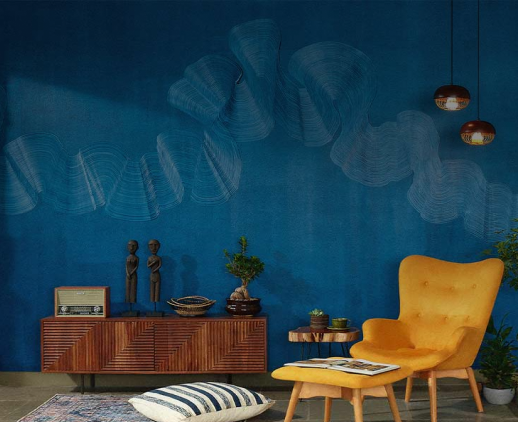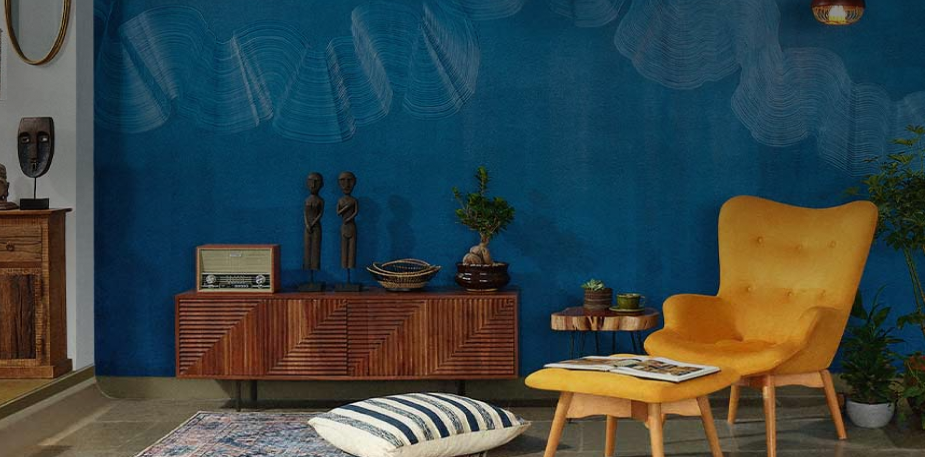Get your home interior design budget estimate
Asian Paints’ Trend Forecast for 2023 is about revival and rebirth

ColourNext is a comprehensive forecast of trends in colours, materials, textures and finishes that's relevant for the subcontinent. The fourth trend, Shroom, is about taking all that is dead and turning it back to life as we come out of isolation
There’s a sprawling kingdom just below our surfaces, silently creating life that sustains and balances ecosystems. The mycelic world or the world of fungi, that sometimes reveals itself through little nooks and crannies, has captured our imaginations like never before, emerging as the new frontier for science, art and everything in between. For millennia, mushrooms— the fruiting part of mycelium—have been associated with decay and decomposition or at the very best as a symbol of counter-culture. But now we are waking up to the knowledge that these vast, interconnected hyphae are actually a story of revival and rebirth, taking all that is dead and turning it back to life, in many ways mirroring the year itself, as we come out of isolation and the biggest healthcare our generations have witnessed.
Eating Differently
Mushrooms have been a part of some Asian cuisines for centuries, hailed both for their medicinal and nutritional value as well as their sharp umami flavour. The humble little fungi have gained global dominance only in the past few years as, increasingly, people look to alternatives for meat and turn towards plantbased diets. What was once popular only as the second most popular pizza topping has now gained its place of pride on our tables as eating fresh, natural and foraged food has become the new way of eating better.

Alternatives for meat and turn towards plant-based diets. Image courtesy, Unsplash

India is a hotbed for mushroom farming. Image courtesy, Shutterstock
Urban Farming
The wellness and sustainability zeitgeist has prompted all of us to grow things and urban farming has emerged as a popular hobby. We’re growing things everywhere we can, in our kitchens, on our terraces, in our cupboards and sometimes even on sidewalks. Among this newfound love for all things homegrown, mushrooms have made for a relatively easy crop, we can even grow it in our bedrooms. India has emerged as a hotbed for mushroom farming, as farmers and small entrepreneurs have realised its potential and skyrocketing demand.
Contemporary Biotechnology and Preventive Medicine
Once the poster child of 1970’s counter-culture, mushrooms are fast gaining recognition as nutraceuticals and pharmaceuticals. Mycologist Paul Stamets has called them “nature’s miniature pharmaceutical factories” with mushroom-based powders and pills entering the mainstream and getting legalized in several parts of the world. Researchers and medical practitioners are now making a case for legalizing the use of psilocybin to treat problems.

Microdosing Benefits and Drawbacks.

Model Valentina Sampaio attends the 2021 Met Gala in an Iris Van Herpen dress inspired by the mycelic world. Image courtesy, Getty Images
Ruling the Runway
They’ve sprouted regularly on the runways in the past year as the fashion world tried to capture mushrooms’ endlessly mesmerizing qualities. Bioluminescence, amorphic form, unmatched intricacies and an implied grooviness became the theme for designers Iris Van Herpen, Rahul Mishra, Ashish and Alexander McQueen, while Stella McCartney and Hermes have taken it one step further with the launch of vegan leather that they are now using for handbags and clothing.
COLOUR FORECAST
Haptic Feeling Grooviness
Absorbing and layered, the colour palette is reminiscent of the quiet strength and tenacity of natural elements in all their strangeness and familiarity. With a rich sense of haptic cognizance, the creams and beiges are elemental while the pinks and blues hint at the inherent grooviness and intrigue of the wild fungi.

A colour palette reminiscent of the tenacity of natural elements in all their strangeness and familiarity.
MATERIAL FORECAST

Agate—A semiprecious form of quartz, agate emulates the layers of turkey tail mushrooms.
Hard Materials
Bringing out the uneven, porous surfaces seen on mushrooms, the diverse set of materials represents micro-textures, imperfections and interconnections found in the mycelic world. These materials can be manipulated into an array of formerly unseen forms with an unreal edge and surreal quality.
Soft Materials
The materials are made to mimic the intricacy and diversity of the fascinating fungi. Simultaneously delicate and strong, while materials such as marbelised fabrics incorporate mushrooms' psychedelic properties, others take inspiration from the layers, unevenness and velvety smoothness of mushrooms. Some of these materials have a homegrown quality as they are made of actual mycelium.

Pleated fabrics replicate mushrooms fins while laser cut fabrics are made to resemble the mushroom veil.
WALLPAPER & TEXTURE FORECAST
Fluid Forms & Tactile Surfaces
Intricate and diverse, the wallpapers bring out all the inherent glory of mushrooms, with their varied textures, colours, behaviours and forms. The collection adds a natural yet unpredictable depth to a room with mesmeric textures and patterns, bringing forth a formerly underground, surprising world.
Visually & Stimulating Abstract
A collection of micro-textures that bring out the interconnectedness and layers of mushrooms with their fluid forms and tactile surfaces, these sensory textures range from waxy and smooth to shiny and threadlike, showcasing the diversity, strangeness and strength of mycelium.

Paper Bloom Wallpaper.

Royale Play Fern Texture.
DESIGN EXAMPLES
Giancarlo Mattioli’s Nesso lamp, designed in the 1970s, has become a legend in itself, selling for thousands of dollars on Ebay.
Canadian musician Tarun Nayar is harnessing the sound of the mycelic world. The Hindustani classical singer and biologist says his music is organismic and uplifting, he calls it ‘plant ragas’.
Artist Alex Morrison showcases how the subcultural icon that once stood for rebellion and activism went on to become domesticated and ornamental.
Designer Brandon Maxwell looked to mushrooms to create colourful graphics for his spring/summer 2022 collection.
Soft and luminescent or bright and layered, mushrooms lend inspiration to a host of products from rugs to mirrors.
Belgian design company Permafungi uses the leftovers of oyster mushrooms to make lampshades and packaging material. Showcased here is Permafungi’s mycelium-based building material with a map of Brussels.
TITLE IMAGE On Console table- Peninsula planter by Botanical Bias; Rose quartz décor object by Essajees.

Get Started with your interior design journey with us!
Speak to our design professionals
What’s the status of your home possession?
What’s the condition of your home/space?
Will you be living in your space during the renovation?
 Previous Question
Previous Question
Is your interior design budget over 4 lakhs?
 Previous Question
Previous Question
Book next available appointment slots with our experts!
Please Select Date and Day
 Previous Question
Previous Question

Something went wrong!
We were unable to receive your details. Please try submitting them again.

Appointment Scheduled!
Thank you for giving an opportunity to Asian Paints Beautiful Homes Service! Our Customer Experience Specialist will get in touch with you soon.
Appointment Date & time
Thank You!
Our team will contact you for further details.
What’s the status of your home possession?
What’s the condition of your home/space?
Will you be living in your space during the renovation ?
 Previous Question
Previous Question
Is your interior design budget over 4 lakhs?
 Previous Question
Previous Question
Book next available appointment slots with our experts!
DEC 2023
Please Select Date and Day
 Previous Question
Previous Question

Something went wrong!
We were unable to receive your details. Please try submitting them again.

Appointment Scheduled!
Thank you for giving an opportunity to Asian Paints Beautiful Homes Service! Our Customer Experience Specialist will get in touch with you soon.
Appointment Date & time
17 Oct 23, 03.00PM - 04.00PM








































